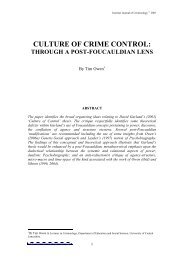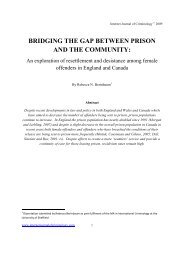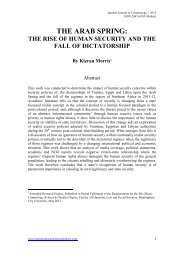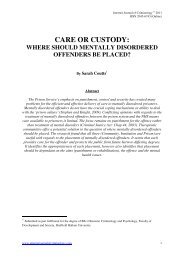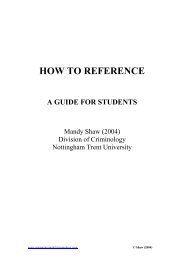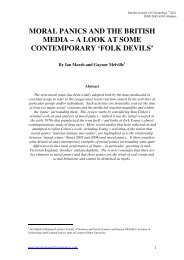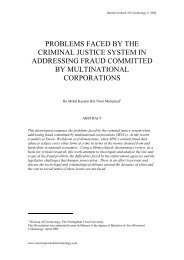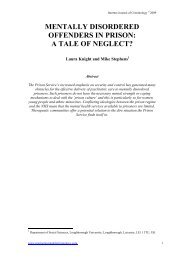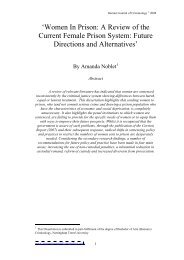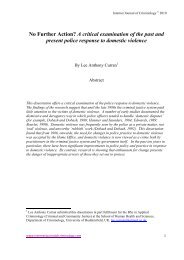the dialogic nature of latrinalia - Internet Journal of Criminology
the dialogic nature of latrinalia - Internet Journal of Criminology
the dialogic nature of latrinalia - Internet Journal of Criminology
You also want an ePaper? Increase the reach of your titles
YUMPU automatically turns print PDFs into web optimized ePapers that Google loves.
<strong>Internet</strong> <strong>Journal</strong> <strong>of</strong> <strong>Criminology</strong> © 2011<br />
ISSN 2045-6743 (Online)<br />
IDENTITY AND IDEOLOGY:<br />
THE DIALOGIC NATURE OF LATRINALIA<br />
By Adam Trahan 1<br />
Abstract<br />
Graffiti has been an important cultural phenomenon throughout history. However,<br />
research has yet to explore how <strong>the</strong> characteristics <strong>of</strong> <strong>the</strong> medium itself influence <strong>the</strong><br />
graffiti for which it serves as a backdrop. One <strong>of</strong> <strong>the</strong> most unique mediums in which<br />
graffiti regularly appears is public restrooms, which <strong>of</strong>fer potential graffitists almost<br />
complete anonymity. This study analyzed <strong>the</strong> content and communicative features <strong>of</strong> 323<br />
graffito in public restrooms and <strong>the</strong>ir relation to <strong>the</strong> <strong>nature</strong> <strong>of</strong> <strong>the</strong> space and larger sociocultural<br />
values. The results show that no particular ideological paradigm is predominant<br />
among <strong>the</strong> graffiti. Ra<strong>the</strong>r, <strong>the</strong> anonymity <strong>of</strong> <strong>the</strong> medium acts to preserve an ongoing<br />
ideological debate where identity is formed and reframed throughout.<br />
1<br />
University <strong>of</strong> North Texas , Department <strong>of</strong> Criminal Justice, Texas, USA<br />
www.internetjournal<strong>of</strong>criminology.com 1
<strong>Internet</strong> <strong>Journal</strong> <strong>of</strong> <strong>Criminology</strong> © 2011<br />
ISSN 2045-6743 (Online)<br />
Graffiti has been an important cultural phenomenon throughout history. It is<br />
visible on almost every conceivable surface from ancient Roman bathhouses to modernday<br />
elementary school desktops (Tanzer, 1939; Reisner and Wechsler, 1974). With such<br />
a bounty <strong>of</strong> material to draw on, graffiti has been studied by a variety <strong>of</strong> scholars from<br />
different disciplines. What has been missing from scholarly debate, however, is an<br />
explanation <strong>of</strong> <strong>the</strong> “refracting power that <strong>the</strong> peculiar characteristics <strong>of</strong> any medium<br />
exercises on <strong>the</strong> value-system for which it serves as an outlet” (Gonos, Mulkern, and<br />
Poushinsky, 1976, pp.40). If we are to observe and analyze graffiti through <strong>the</strong> lens <strong>of</strong><br />
culture, <strong>the</strong> specific context in which graffiti appears may be a powerful determinant <strong>of</strong><br />
its content and purpose.<br />
Dundes (1966) coined <strong>the</strong> term “<strong>latrinalia</strong>” to refer to graffiti that appears in<br />
public restrooms. Public restrooms are a distinctive medium because <strong>the</strong>y <strong>of</strong>fer <strong>the</strong><br />
potential graffitist almost complete anonymity. This anonymity allows <strong>the</strong> opportunity to<br />
use language and express opinions and attitudes that are taboo in ordinary social life. It is<br />
plausible, <strong>the</strong>n, that anonymous graffiti is a uniquely accurate and unrestricted expression<br />
<strong>of</strong> sentiment (McGlynn, 1972).<br />
Literature<br />
In one <strong>of</strong> <strong>the</strong> earliest empirical studies <strong>of</strong> graffiti in public restrooms, Dundes<br />
(1966) developed a taxonomy <strong>of</strong> <strong>the</strong> different topics commonly addressed in <strong>latrinalia</strong>.<br />
He found that <strong>latrinalia</strong> tends to center on five different topical <strong>the</strong>mes. First, most<br />
<strong>latrinalia</strong> consist <strong>of</strong> advertisements and solitictations, most <strong>of</strong> which are sexual in <strong>nature</strong>.<br />
Second were requests or demands concerning bodily functions. The final three topical<br />
<strong>the</strong>mes were directions, commentaries, and personal introspection. Dundes also found<br />
that graffiti was less frequent in women’s restrooms compared to men’s. Dundes’ study<br />
would come to characterize much <strong>of</strong> <strong>the</strong> subsequent research on <strong>latrinalia</strong> in that two<br />
areas <strong>of</strong> inquiry – topical content and gender disparities – dominate <strong>the</strong> extant literature.<br />
Kinsey et al. (1953) were <strong>the</strong> next to empirically analyze graffiti in public<br />
restrooms. Their primary interest was in exploring <strong>the</strong> sexual content <strong>of</strong> <strong>latrinalia</strong>.<br />
Kinsey in particular posited that <strong>the</strong> sexual messages inscribed on bathroom walls could<br />
provide insight into <strong>the</strong> extent and <strong>nature</strong> <strong>of</strong> people’s suppressed sexual desires. He<br />
found that much <strong>of</strong> <strong>the</strong> bathroom graffiti, particularly in men’s bathrooms, were<br />
homosexual in content. Two possible explanations for <strong>the</strong> prevalence <strong>of</strong> homosexual<br />
content were posited: (1) homosexual individuals (men) are more likely to write about<br />
sexuality in public restrooms given that <strong>the</strong>ir audience are members <strong>of</strong> <strong>the</strong> same sex, or<br />
(2) interest in anatomy and function <strong>of</strong> organs. Findings also showed that men produced<br />
more graffiti than women.<br />
This study was replicated in 1975 by Farr and Gordon. The purpose <strong>of</strong> <strong>the</strong>ir<br />
replication was to determine whe<strong>the</strong>r <strong>the</strong> gender gap identified by Kinsey had narrowed<br />
as a result <strong>of</strong> <strong>the</strong> sociocultural liberation women experienced during <strong>the</strong> 60s and 70s.<br />
They found that <strong>the</strong> proportion <strong>of</strong> <strong>latrinalia</strong> that appeared in women’s restrooms had<br />
increased from 25 percent to 44 percent. Fur<strong>the</strong>rmore, <strong>the</strong> overall quantity <strong>of</strong> women’s<br />
<strong>latrinalia</strong> had also increased. Despite observed increases in <strong>the</strong> absolute and relative<br />
www.internetjournal<strong>of</strong>criminology.com 2
<strong>Internet</strong> <strong>Journal</strong> <strong>of</strong> <strong>Criminology</strong> © 2011<br />
ISSN 2045-6743 (Online)<br />
quantity <strong>of</strong> <strong>latrinalia</strong> in women’s restrooms, however, men’s <strong>latrinalia</strong> was still more<br />
common than women’s.<br />
The supposed gender gap in <strong>latrinalia</strong> was fur<strong>the</strong>r investigated by Arluke,<br />
Kutak<strong>of</strong>f, and Levin (1987). Their data showed that, much <strong>the</strong> same as earlier research,<br />
women’s <strong>latrinalia</strong> is comparatively rare and significantly less likely to contain sexual<br />
references. Even in instances when women did write about sexuality, <strong>the</strong>ir language<br />
tended to be less obscene and more conventional. The authors concluded that <strong>the</strong> cultural<br />
revolutions <strong>of</strong> <strong>the</strong> 1960s and 1970s had little-to-no impact on gender mores as expressed<br />
in <strong>latrinalia</strong>.<br />
In a more recent study, Bartholome and Snyder (2004) analyzed both qualitative<br />
and quantitative differences in graffiti found in a men and women’s restroom at a<br />
restaurant in Rochester, New York. Their finding revealed no significant difference in<br />
<strong>the</strong> relative quantity <strong>of</strong> men and women’s <strong>latrinalia</strong>. Of <strong>the</strong> 269 inscriptions <strong>the</strong>y<br />
transcribed, 52% were written by women and 48% were written by men. The overall<br />
content <strong>of</strong> <strong>the</strong> graffiti also differed little between men and women. Both gender groups<br />
wrote primarily about heterosexual attitudes and behavior. One important difference<br />
between Bartholome and Snyder’s research compared to <strong>the</strong> studies that preceded <strong>the</strong>irs<br />
was that patrons were encouraged to write graffiti in <strong>the</strong> restrooms at <strong>the</strong> restaurant where<br />
<strong>the</strong>y collected data. Thus, <strong>the</strong> graffiti included in <strong>the</strong>ir study did not represent an illicit or<br />
illegal act. Whe<strong>the</strong>r graffiti is an act <strong>of</strong> deviance or not is likely to have an impact on<br />
both <strong>the</strong> content <strong>of</strong> <strong>the</strong> messages and <strong>the</strong> frequency with which <strong>the</strong>y appear in any given<br />
space (Ferrell, 1996).<br />
What has been absent from scholarly research is an exploration <strong>of</strong> <strong>latrinalia</strong> as<br />
social discourse. Past research has treated <strong>latrinalia</strong> as a unidirectional communicative<br />
device. That is, studies ei<strong>the</strong>r implicitly or explicitly assume that graffiti in public<br />
restrooms is a form <strong>of</strong> expression whereby <strong>the</strong> author makes a statement that subsequent<br />
patrons passively receive and interpret. This represents a somewhat inaccurate<br />
conceptualization <strong>of</strong> <strong>the</strong> operative features <strong>of</strong> <strong>latrinalia</strong>, which is a conspicuously<br />
bidirectional exchange <strong>of</strong> attitudes, identity, and ideology. Despite <strong>the</strong> absence <strong>of</strong> extant<br />
empirical research on <strong>the</strong> communicative features <strong>of</strong> <strong>latrinalia</strong>, two competing <strong>the</strong>oretical<br />
models have been <strong>of</strong>fered that were used to guide <strong>the</strong> analysis presented here.<br />
Stocker, Dutcher, Hargrove, and Cook (1972), in what has been termed <strong>the</strong><br />
structural <strong>the</strong>ory <strong>of</strong> graffiti content, argued that graffiti is an accurate indicator <strong>of</strong> <strong>the</strong><br />
consensual values <strong>of</strong> <strong>the</strong> community in which it is written. They provide some specific<br />
examples regarding homosexual graffiti, principally that <strong>the</strong> frequency <strong>of</strong> homosexual<br />
graffiti will decrease as a result <strong>of</strong> <strong>the</strong> liberalizing influence <strong>of</strong> Gay Liberation. Gonos et<br />
al. (1976) challenged this <strong>the</strong>ory by creating a framework which essentially alleged <strong>the</strong><br />
opposite – that <strong>the</strong> communicative content (and frequency) <strong>of</strong> graffiti will vary inversely<br />
with relevant dominant values.<br />
Central to Gonos et al.’s (1976) <strong>the</strong>sis is <strong>the</strong> assumption that as societal values<br />
undergo change, sentiments that challenge dominant values will manifest covertly as<br />
anonymous graffiti. There is a general consensus, best represented by postmodern<br />
<strong>the</strong>ory, that society is currently experiencing drastic change (Best and Kellner, 1991).<br />
Thus, if Gonos et al.’s (1976) <strong>the</strong>ory is accurate, now is <strong>the</strong> time when anonymous<br />
graffiti’s challenge to accepted norms should be especially pronounced.<br />
www.internetjournal<strong>of</strong>criminology.com 3
Data and Methods<br />
<strong>Internet</strong> <strong>Journal</strong> <strong>of</strong> <strong>Criminology</strong> © 2011<br />
ISSN 2045-6743 (Online)<br />
What follows is <strong>the</strong> results <strong>of</strong> an analysis <strong>of</strong> bathroom graffiti recorded during<br />
approximately 21 hours <strong>of</strong> data collection. During this time, I visited 42 men’s<br />
bathrooms in seven different buildings on a Division 1 university campus in <strong>the</strong> Midwest.<br />
The number <strong>of</strong> graffiti messages recorded totaled 323. Only eight pictures were<br />
observed. During data collection, I also conducted an unobtrusive observation <strong>of</strong><br />
patrons’ behavior in order to identify <strong>the</strong> socio-cultural rules that govern individual<br />
behavior and interaction in men’s bathrooms. Doing so is essential to establishing a<br />
context for <strong>the</strong> analysis and interpretation <strong>of</strong> <strong>the</strong> results.<br />
The 323 graffiti were analyzed using <strong>the</strong>matic content analysis. Thematic content<br />
analysis is a widely used technique for identifying and analyzing <strong>the</strong>mes in qualitative<br />
data. 2 The six phase analytic procedure followed here involved reviewing <strong>the</strong> data to<br />
identify sweeping patterns and common elements. Once <strong>the</strong> patterns were identified, <strong>the</strong><br />
internal homogeneity and external heterogeneity <strong>of</strong> all <strong>the</strong>mes were assessed to ensure<br />
that <strong>the</strong> <strong>the</strong>mes are reliable. Inter-rater reliability and Cohen’s Kappa was also conducted<br />
to test <strong>the</strong> reliability <strong>of</strong> <strong>the</strong> results. This analysis yielded a Kappa score <strong>of</strong> .746, which<br />
was significant at <strong>the</strong> .01 level.<br />
Results<br />
During data collection, I observed four rules that governed bathroom behavior. 3<br />
Behavior that violated (or ignored) <strong>the</strong>se rules was met on almost every occasion with<br />
unspoken disapproval or increased discomfort on <strong>the</strong> part <strong>of</strong> o<strong>the</strong>r patrons.<br />
1) No talking – men do not converse in <strong>the</strong> bathroom.<br />
2) No eye contact – men look directly ahead at <strong>the</strong> wall only inches from <strong>the</strong>ir<br />
face when using urinals and do not acknowledge each o<strong>the</strong>rs presence at any<br />
time.<br />
3) No lingering – men do not socialize in <strong>the</strong> restroom. They stay only <strong>the</strong><br />
necessary amount <strong>of</strong> time.<br />
4) No showing emotion – men’s restrooms are generally impassive places<br />
These rules seem to reflect dominant values that demonize homosexuality. In public<br />
restrooms, men are required to expose <strong>the</strong>mselves in <strong>of</strong>tentimes crowded, close quarters.<br />
The fact that all four rules minimize interaction and individual identity (e.g., don’t talk or<br />
exhibit emotions), suggest that <strong>the</strong>y are intended to reduce homophobic discomfort. In<br />
this context, Stocker et al.’s (1972) <strong>the</strong>ory would suggest that <strong>the</strong> graffiti messages would<br />
be homophobic, while Gonos et al.’s (1976) <strong>the</strong>ory would postulate that homosexual<br />
content would dominate.<br />
The results revealed that both homophobic and homosexual graffiti were equally<br />
prominent. No particular ideological paradigm whatsoever “dominated” any o<strong>the</strong>r.<br />
Instead, <strong>the</strong> dialogue between ideologies was paramount. Virtually all graffiti messages<br />
that advanced some perspective were challenged by o<strong>the</strong>r messages. The graffiti<br />
2<br />
For a detailed review <strong>of</strong> <strong>the</strong>matic content analysis, see Braun and Clarke (2006).<br />
3<br />
This specific point is applicable only to men’s restrooms, <strong>the</strong> specific focus <strong>of</strong> this analysis.<br />
www.internetjournal<strong>of</strong>criminology.com 4
<strong>Internet</strong> <strong>Journal</strong> <strong>of</strong> <strong>Criminology</strong> © 2011<br />
ISSN 2045-6743 (Online)<br />
represented an argument <strong>of</strong> sorts. These arguments typically involved multiple messages<br />
by multiple authors. Fur<strong>the</strong>r, <strong>the</strong> messages were patterned in a temporal sequence. Most<br />
<strong>of</strong>ten, response statements (i.e., messages that were a clear response to o<strong>the</strong>r messages)<br />
appeared below <strong>the</strong> messages <strong>the</strong>y were intended to respond to. Thus, an observer could<br />
read <strong>the</strong> graffiti dialogue as it occurred through time. This phenomenon appeared as<br />
illustrated by <strong>the</strong> following statement(s):<br />
“Whoever draws a dick on <strong>the</strong> wall is not straight”<br />
“Actually, <strong>the</strong>y’re straight gay”<br />
“So are you you fucking fag”<br />
“Everyone loves a homophobe”<br />
Responses also manifested as a circular pattern. Although this patterning was far<br />
less frequently pronounced than <strong>the</strong> temporal sequence, it occurred when <strong>the</strong> original<br />
statement, i.e., <strong>the</strong> message(s) being responded to, was unusually hostile and antagonistic.<br />
In <strong>the</strong>se instances, an original statement appeared in <strong>the</strong> middle <strong>of</strong> response statements<br />
that literally encircled it. This manifestation suggested that response statements were<br />
responding not only to <strong>the</strong> substance <strong>of</strong> <strong>the</strong> original statements, but also to <strong>the</strong>ir tone.<br />
Circular patterning allowed multiple response messages to be leveled at one original<br />
statement. While temporal patterning only allowed one response statement to appear<br />
below its target, circular patterning was, on average, composed <strong>of</strong> one original statement<br />
and five response statements. Also, it is plausible that <strong>the</strong> “encircling” <strong>of</strong> <strong>the</strong> original<br />
message implied a desire to contain its sentiment. The following statement is<br />
representative <strong>of</strong> graffiti that appeared as a circular response pattern:<br />
(2)<br />
(1) “If you wrote this you’re gay, Bitch.”<br />
“FUCK RELIGION”<br />
(OS)<br />
“Homosexuality is a sin<br />
“Fuck all you homophobic and all fags go to Hell”<br />
discriminatory males”<br />
(3) “I will fucking rape all you fucking<br />
Jesus freaks.” (4)<br />
This mosaic contains an original statement (OS) with two underlying elements –<br />
religion and homophobia. The response statements were leveled at (1) religion as an<br />
institution, (2) <strong>the</strong> author <strong>of</strong> <strong>the</strong> original statement, (3) homophobic men in general, (4)<br />
and religious people in general. They “contain” <strong>the</strong> original statement not only on <strong>the</strong><br />
bathroom wall, but also by challenging all <strong>the</strong> outlets that religious homophobic ideology<br />
has in its arsenal – <strong>the</strong> institution <strong>of</strong> religion and its subscribers.<br />
www.internetjournal<strong>of</strong>criminology.com 5
Thematic Content<br />
<strong>Internet</strong> <strong>Journal</strong> <strong>of</strong> <strong>Criminology</strong> © 2011<br />
ISSN 2045-6743 (Online)<br />
Although <strong>the</strong> content <strong>of</strong> <strong>the</strong> graffiti observed and recorded ranged from poetic<br />
statements regarding human potential to lists <strong>of</strong> bathrooms on campus where <strong>the</strong> author<br />
had masturbated, three strongly pronounced <strong>the</strong>mes emerged. The most common <strong>the</strong>me<br />
– sexuality – involved homophobic, homosexual, and heterosexual messages and<br />
pictures. Religious and antireligious statements and pictures were somewhat less<br />
frequent, but sometimes related to, sexuality graffiti. The least frequent <strong>the</strong>me observed<br />
was humorous graffiti. It is worthwhile to note here that pictures were rare. Over 97% <strong>of</strong><br />
recorded graffiti were written statements. This suggests that advancing a certain ideology<br />
is a key intention <strong>of</strong> <strong>latrinalia</strong>. The meaning <strong>of</strong> any picture can be vague whereas it is far<br />
more difficult to misinterpret <strong>the</strong> meaning <strong>of</strong>, for example, this statement found on <strong>the</strong><br />
inside <strong>of</strong> a stall door: “I hate Jews and fags.”<br />
Sexuality<br />
Although <strong>the</strong> total number <strong>of</strong> homophobic statements recorded was much larger<br />
than that for homosexual statements, <strong>the</strong> difference virtually disappeared when <strong>the</strong> antihomophobic<br />
statements were added to <strong>the</strong> homosexual ones. Also, <strong>the</strong>se messages were<br />
comprised <strong>of</strong> almost entirely antagonistic statements. The implication here is that<br />
“sexuality” statements are not expressions <strong>of</strong> sexuality per se, but ideological statements.<br />
Homophobic statements are, <strong>of</strong> course, inherently antagonistic, but <strong>the</strong>y were countered<br />
on almost all instances observed by homosexual and/or anti-homophobic messages.<br />
Homosexual messages typically consisted <strong>of</strong> simple declaratory statements <strong>of</strong><br />
homosexuality in response to homophobic statements. For example:<br />
“Y U looking left fag?”<br />
“Fuck you I’m gay”<br />
Interestingly, although most anti-homophobic messages were simple defamations<br />
<strong>of</strong> <strong>the</strong> ideology and its subscribers (e.g., “Fuck you and your homophobic shit”), many<br />
were attacks leveled against “frat boys.” These messages were not necessarily responses<br />
to homophobic statements written by fraternity members. 4 Ra<strong>the</strong>r, <strong>the</strong>y are likely a<br />
function <strong>of</strong> fraternity stereotypes whereby fraternities become symbols <strong>of</strong> male<br />
heterosexuality and, arguably, homophobia in a university setting. It seems some authors<br />
<strong>of</strong> anti-homophobic statements assign an identity to <strong>the</strong> ideology <strong>the</strong>y are attacking.<br />
Although quite rare, heterosexual statements were typically expressions <strong>of</strong><br />
sexuality. They sometimes contained minor levels <strong>of</strong> antagonism, but even in <strong>the</strong>se<br />
instances <strong>the</strong> sexually expressive component was forefront (e.g., “I cumed on your<br />
mom’s tits). Also, <strong>the</strong>y were typically not involved in <strong>the</strong> dialogue – <strong>the</strong>y were not<br />
response statements nor did <strong>the</strong>y evoke any.<br />
4<br />
There was not one instance where such statements were accompanied by fraternity symbols or any o<strong>the</strong>r<br />
indication <strong>of</strong> membership in a fraternity.<br />
www.internetjournal<strong>of</strong>criminology.com 6
Religiosity<br />
<strong>Internet</strong> <strong>Journal</strong> <strong>of</strong> <strong>Criminology</strong> © 2011<br />
ISSN 2045-6743 (Online)<br />
The majority <strong>of</strong> religious messages recorded were short declaratory statements<br />
such as “trust Jesus” and “Jesus is lord.” This does not, however, mean that religiosity<br />
does not have its place in <strong>the</strong> ideological battles occurring on <strong>the</strong> bathroom walls.<br />
Religious messages were <strong>of</strong>ten backdrops upon which <strong>the</strong>se argumentative debates<br />
appeared. For example, <strong>the</strong> phrases “TRUST JESUS” and “JESUS IS LORD” were<br />
literally written across debates concerning sexuality.<br />
Religious graffiti manifested was as a response to entire debates. The “backdrop”<br />
it provides seems to suggest a context in which <strong>the</strong> debate should occur. Each one <strong>of</strong><br />
<strong>the</strong>se messages contained some indicator <strong>of</strong> its pertinence to a set <strong>of</strong> o<strong>the</strong>r messages. The<br />
general <strong>the</strong>me religious graffiti took on <strong>the</strong> bathroom walls was evangelical. Virtually all<br />
religious statements seemed to suggest to <strong>the</strong> homophobe and <strong>the</strong> homosexual that <strong>the</strong>y<br />
both need to “Give your life to Jesus,” as one graffitist wrote. The authors <strong>of</strong> religious<br />
messages are advocating <strong>the</strong>ir ideology as strongly as o<strong>the</strong>rs because, as one statement<br />
appeared, “without Jesus you’ll be in HELL.”<br />
Humor<br />
Humorous graffiti had many unique characteristics. It was <strong>the</strong> only style <strong>of</strong><br />
graffiti that appeared outside <strong>of</strong> <strong>the</strong> toilet stalls. It was also <strong>the</strong> only style that did not<br />
include any <strong>dialogic</strong> component. Humorous messages were never response statements,<br />
nor did <strong>the</strong>y generate any. Ra<strong>the</strong>r, <strong>the</strong>y manifested in two distinct ways. Humorous<br />
graffiti most <strong>of</strong>ten appeared inside bathroom stalls and were almost always short (i.e.,<br />
two to four lines) rhyming jokes that reflect <strong>the</strong> <strong>nature</strong> <strong>of</strong> <strong>the</strong> space. Public restrooms<br />
have a very specific purpose – to provide a space for <strong>the</strong> dispensing <strong>of</strong> bodily waste<br />
outside <strong>the</strong> home. The focus <strong>of</strong> virtually all humorous graffiti that were recorded inside<br />
stalls was urination, defecation, or genitalia. For example:<br />
“I’m sitting on <strong>the</strong> shitter and feel so bitter because my asshole’s<br />
so tight I can’t squeeze one out tonight”<br />
Humorous graffiti also appeared outside <strong>the</strong> stalls on <strong>the</strong> walls <strong>of</strong> <strong>the</strong> bathroom<br />
itself. The walls <strong>of</strong> <strong>the</strong> bathrooms observed were all constructed using large brick-like<br />
objects bounded with grout. In almost most every case where graffiti appeared on <strong>the</strong>se<br />
walls, <strong>the</strong> statements were written on <strong>the</strong> grout and were a play on <strong>the</strong> word itself.<br />
“The grout wall <strong>of</strong> China” “Grout expectations”<br />
“Alexander <strong>the</strong> grout” “Oscar <strong>the</strong> grout”<br />
Thus, humorous graffiti seem to be poking fun at both <strong>the</strong> physical environment and <strong>the</strong><br />
<strong>nature</strong> <strong>of</strong> <strong>the</strong> space. They are statements that mock <strong>the</strong> bathroom itself and what <strong>the</strong><br />
author and observers’ presence in it indicates. As previously mentioned, <strong>the</strong> rules that<br />
govern bathroom behavior seem to be mechanisms with which to minimize discomfort.<br />
This discomfort is a function <strong>of</strong> <strong>the</strong> <strong>nature</strong> <strong>of</strong> <strong>the</strong> space, <strong>the</strong> same <strong>nature</strong> that humorous<br />
www.internetjournal<strong>of</strong>criminology.com 7
<strong>Internet</strong> <strong>Journal</strong> <strong>of</strong> <strong>Criminology</strong> © 2011<br />
ISSN 2045-6743 (Online)<br />
graffiti is addressing. Perhaps <strong>the</strong>n humorous graffiti serves <strong>the</strong> same purpose as <strong>the</strong>se<br />
rules. By making fun <strong>of</strong> <strong>the</strong> space and <strong>the</strong> behavior that occurs within it, discomfort is<br />
relieved.<br />
Conclusion<br />
Public graffiti has long been afforded cultural significance (Cohan, 1975;<br />
Castellon, 1978; Ferrell, 1996). However, <strong>the</strong> specific characteristics <strong>of</strong> <strong>the</strong> medium and<br />
its’ role in shaping graffiti has been relatively ignored (Gonos et al., 1976). Also,<br />
ongoing debates have been concerned with graffiti’s reflection <strong>of</strong> societal values. In <strong>the</strong><br />
context <strong>of</strong> <strong>latrinalia</strong>, this <strong>of</strong>ten takes <strong>the</strong> form <strong>of</strong> homophobia vs. homosexuality (Stocker<br />
et al., 1972). This study analyzed 323 graffiti in public restrooms and concluded that no<br />
single <strong>the</strong>me – homosexuality or heterosexuality – dominates. Ra<strong>the</strong>r, <strong>the</strong> dominant<br />
<strong>the</strong>me is best characterized as an impassioned dispute where no single ideology prevails.<br />
The debate is clearly ongoing. It does, however, reflect, as do <strong>the</strong> rules <strong>of</strong> bathroom<br />
behavior observed during data collection, a general discomfort regarding <strong>the</strong> <strong>nature</strong> <strong>of</strong> <strong>the</strong><br />
space where it appears. It seems <strong>the</strong> medium sets <strong>the</strong> agenda and <strong>the</strong> authors take<br />
position, using <strong>the</strong> bathroom stalls as a battleground on which to express <strong>the</strong>ir ideology.<br />
www.internetjournal<strong>of</strong>criminology.com 8
References<br />
<strong>Internet</strong> <strong>Journal</strong> <strong>of</strong> <strong>Criminology</strong> © 2011<br />
ISSN 2045-6743 (Online)<br />
Arluke, A. Kutak<strong>of</strong>f, L, and Levine, J. 1987. Are <strong>the</strong> times changing? An analysis <strong>of</strong><br />
gender differences in sexual graffiti. Sex Roles, 16, pp.1-7.<br />
Bartholome, L., and Snyder, P., 2004. Is it philosophy or pornography? Graffiti at <strong>the</strong><br />
Dinosaur Bar-B-Que. The <strong>Journal</strong> <strong>of</strong> American Culture, 27, pp.86-98.<br />
Best, S., and Kellner, D., 1991. Postmodern <strong>the</strong>ory: Critical interrogations.<br />
New York: Guilford Press.<br />
Castellon, R., 1978. Aes<strong>the</strong>tics <strong>of</strong> graffiti. San Francisco: Library <strong>of</strong> Congress.<br />
Cohan, T., 1975. Street writers: A guided tour <strong>of</strong> Chicano graffiti. Los Angeles:<br />
Acrobat Books.<br />
Dundes, A., 1966. Here I Sit: A Study <strong>of</strong> American Latrinalia. Kroeber<br />
Anthropoligical Society Paper, 34, pp.91-105.<br />
Farr, J.H., and Gordon, C., 1975. A partial replication <strong>of</strong> Kinsey’s graffiti study. The<br />
<strong>Journal</strong> <strong>of</strong> Sex Research, 11, pp.158-162.<br />
Ferrell, J., 1996. Crimes <strong>of</strong> style: Urban graffiti and <strong>the</strong> politics <strong>of</strong> criminality.<br />
Boston: Nor<strong>the</strong>astern University Press.<br />
Gonos, G., Mulkern, V. and Poushinsky, N., 1976. Anonymous expression: A structural<br />
view <strong>of</strong> graffiti. <strong>Journal</strong> <strong>of</strong> American Folklore, 89, pp.40-48.<br />
Kinsey, A.C., Pomeroy, W.B., Martin, C.E., and Gebhard, P.H., 1953. Sexual behavior in<br />
<strong>the</strong> human female. Philadelphia: W.B. Saunders.<br />
McGlynn, P.D., 1972. Graffiti & slogans: Flushing <strong>the</strong> Id. <strong>Journal</strong> <strong>of</strong> Popular Culture,<br />
2, pp.351-356.<br />
Reisner, R.G. and Wechsler, L., 1974. Encyclopedia <strong>of</strong> graffiti. New York:<br />
Galahad Books.<br />
Tanzer, H.H., 1939. The common people <strong>of</strong> Pompeii: A study <strong>of</strong> <strong>the</strong> graffiti. Baltimore:<br />
The John Hopkins Press.<br />
Stocker, T.L. Dutcher, L.W. Hargrove, S.M. and Cook, E.A., 1972. Social analysis <strong>of</strong><br />
graffiti. <strong>Journal</strong> <strong>of</strong> American Folklore, 85, pp.356-366.<br />
www.internetjournal<strong>of</strong>criminology.com 9




